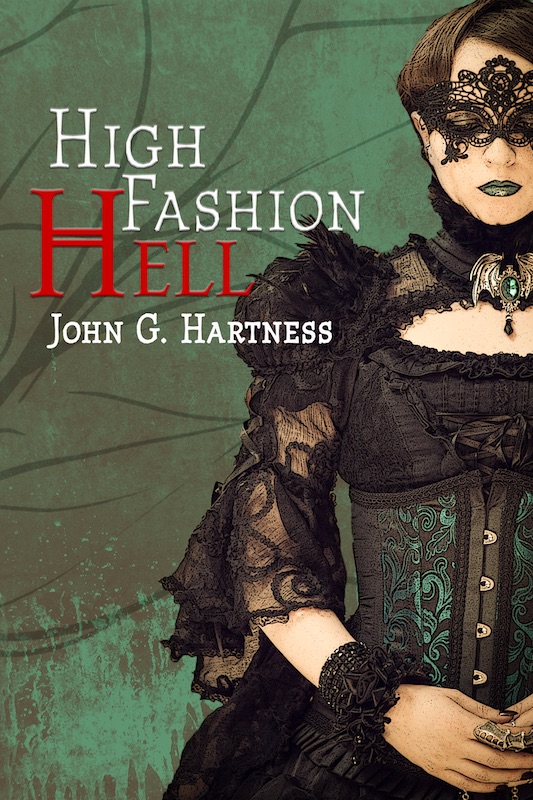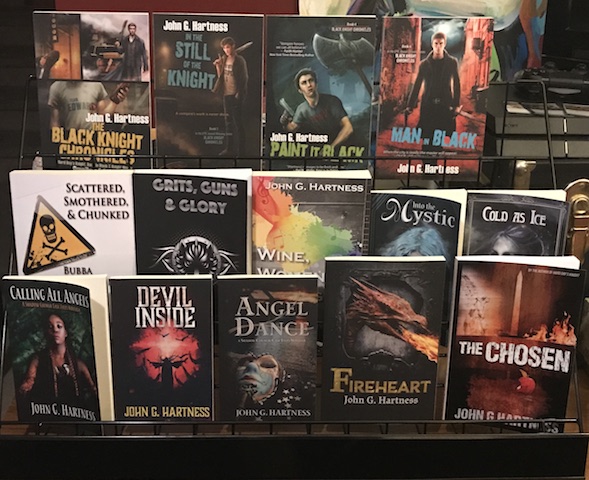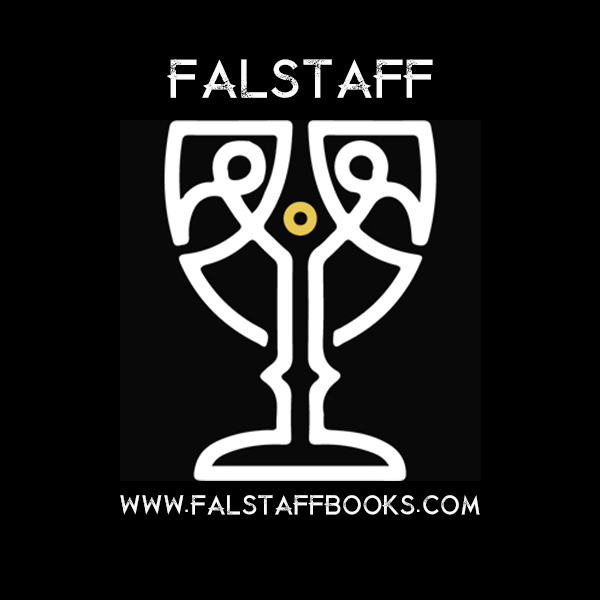
by john | May 2, 2017 | Business of publishing, How to Sell Books, Promos/Giveaways
This is not going to be exciting. None of these posts in this series are going to be exciting. I’m not going to tell you how to jump up the bestseller lists and go from selling five books each month to 5,000 in the span of thirty days. I’m not going to tell you The Secret To Becoming An Amazon Bestseller. I’m not going to tell you how to Make A Million Dollars Selling Ebooks.
I’m not going to do any of that crap. Because those posts are bullshit. The only people getting rich off the words in a bunch of How To Sell Ebooks books are the people that wrote the book. And I’m giving this shit away, so I’m obviously an idiot.
But I’m an idiot who makes a living selling books. So that puts me ahead of most idiots out there.
I pay my bills and feed my family off my writing. Most writers can’t do that. We live modestly, and we try to manage our spending, but we are a single-income family, and that income grows out of my writing. These posts will try to give you some of the tools that I use to sell more books. I’m not looking to make anyone (except me) into the second coming of Stephen King. I just want to help you find more success in your writing.
So let’s start with the basics – a mailing list. You’ve heard you need one, but you don’t know shit about how to build one. You don’t know what a newsletter should look like. You don’t know how to get people to subscribe to it, and you don’t know how to create one that doesn’t look like it was drawn by a three-year-old epileptic chimpanzee. So let’s start there.
Yes, you need a mailing list. Your newsletter is the single most important piece of marketing material that you have, with the exception of writing amazing books. People who sign up for your newsletter, for the most part, are already interested in you and your work. So first you have to create a mailing list, and figure out how to send a newsletter. Then we’ll move on to how to get people to sign up for your mailing list.
Mailing List Services – there are plenty of companies out there that will manage your email list for you. Constant Contact is the one that most big companies use, and you probably get 2-3 emails using that service every day. I use Mailchimp, because it’s cheaper at the level that I’m at. I’m currently at around 2700 people on my email list. That’s not a huge number, but it’s decent. It’s all the better because most of those people are there organically, but we’ll get to that later.
Mailchimp is a subscription service. They charge you for their work. In exchange for your monthly fee, they will collect all the email addresses and give you tools to send out good-looking newsletters and autoresponders to people when they contact you. I currently pay $40/month for this service, because of the number of people I have. I’m not far from looking for another service, because once you get over about 3500 names on your list, Mailchimp isn’t quite as cost-effective. But that’s a discussion for later as well.
Once you sign up with MailChimp, you have to start building a list. First add yourself. That lets you see the emails you send out in their natural and complete form. Then go over to your Facebook Author Page and build a button. Facebook lets you make a Call to Action at the top of your page, and yours should almost certainly say “Join my Email List.” It’s very easy to build the button, Facebook walks you through every step.
Once you’ve built your button on your author page (if you don’t have an author page, that’s a hint – you better get one), then it’s time to post some notices on your personal timeline and on your author page, telling people to sign up for your email list. You have to do this a few times. Facebook doesn’t show everything by everybody, so to get through their signal-to-noise ratio, you have to repeat yourself a few times. Also, you will have better success if you put the link in comments, as FB hides posts with links built in.
Don’t post all the damn time, just once a day or so. Let’s not be complete dicks about this promo thing. Yes, I understand exactly how often I post promotional things myself. But I have a LOT of shit to promote. So I’m not posting the same thing more than once per day.
While you’re waiting for someone to sign up for your mailing list, it’s time to set up some automations. MailChimp lets you create stored newsletters and welcome letters that go out whenever someone signs up for your mailing list. This way, whenever someone signs up to hear from you, they get a nice welcome email from you. A lot of people recommend sending one note within a few hours of signup, then another in a couple of days, then a third a week or two later. I send out two, one an hour or so after signup, then another a few days later. I figure a couple of weeks after they’ve joined the email list, they’ll be getting a newsletter anyway.
That’s always another question – how often should I send out newsletters? I have been doing mine once each month, but I’m about to increase to twice a month. Some folks send stuff out weekly, but I think that’s a little much. You want people to remember you, but not get tired of hearing from you. If you only have a few releases each year, then once a month is probably fine. But it is important to stay on top of it and send stuff out. Even if you don’t have a new book coming out, you can solicit reviews for older work, pitch your upcoming audio releases, publicize events and appearances, or promote stuff by your friends. All of those make for good newsletter fodder.
But you must send out your newsletter regularly. That’s the only way it’s going to get traction and you’re going to be “sticky” in people’s heads.
I’ll be back next week with talk about ways to grow a newsletter, like newsletter swaps, and incentives. If there are questions about what I’ve written this week, leave them in the comments! Thanks!
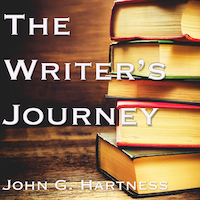
by john | Apr 19, 2017 | Business of publishing, Podcast, The Writer's Journey
 One last Mysticon episode! This time I talked with my friend Margaret McGraw about her website, her evolution as a writer, her journey to success, and upcoming projects like Lawless Lands, coming this summer from Falstaff Books. You can subscribe to the podcast on iTunes or any of those other podcasty-type places, or you can click here to listen to it in your browser.
One last Mysticon episode! This time I talked with my friend Margaret McGraw about her website, her evolution as a writer, her journey to success, and upcoming projects like Lawless Lands, coming this summer from Falstaff Books. You can subscribe to the podcast on iTunes or any of those other podcasty-type places, or you can click here to listen to it in your browser.

by john | Mar 23, 2017 | Business of publishing, Writing
As a lot of folks here know, in 2016 I started a small publishing company, Falstaff Books. As such, I look through a fair number of manuscript submissions. I don’t read all of them at first, there’s a team of slush readers that do that. But I sometimes poke my head into the slush pile, and I read everything that gets kicked up the food chain to me.
That means I see some truly interesting things done with formatting of documents. Despite the fact that we publish pretty clear submission guidelines on our website (click the big red button that says “submissions” to see these), we’ll occasionally get some manuscripts that do not follow the guidelines. I don’t know if this is ignorance, hubris, or just stupidity that causes people to ignore the clearly stated guidelines, but it will frequently result in a rejection without the submission ever being read.
Here’s why – I have enough books under contract to not accept another title for publication before 2020, and we’d still be really busy.
We are a very small press. We do not pay advances at this point. We do not have national bookstore placement yet. We have a very small media footprint. We have won no major awards for our books, and have only a few thousand people on our newsletter and social media reach. And we still have so many amazing books in the pipeline that if I didn’t accept another book for two years, we’d still be able to publish multiple books every month for the next three years.
If we are that inundated with talented writers and quality manuscripts at this point in our evolution, how backed up do you think places like Apex or Angry Robot or Baen are? Those folks have been around much longer and have much better distribution, so if you think they aren’t way busier than I am, you’re smoking the good shit.
If you mail me the good shit, I might forgive some of your formatting stupidity.
So that’s what it boils down to with some guidelines – give an editor the shit they want in the format they want it, because doing anything else gives them an excuse to reject your manuscript and move on the next amazing submission in the pile.
But I’m going to go point by point in our guidelines and tell you exactly why they exist. So you don’t sit there and say “That Hartness guy is just an arbitrary asshat that hates kittens and rejected my manuscript because I mailed a hard copy in on cat stationary.”
First off, we only accept email submissions. I don’t have a PO Box, I don’t want a PO Box, and there is no way in hell I want you crazy fuckers showing up at my door with rose-scented perfumed manuscripts.
Secondly, fuck you, I love cats.
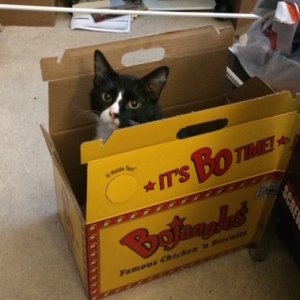
See? That’s my cat. In a Bojangle’s box. He’s fucking adorable.
So here are the guidelines, pulled straight from our website as of today, March 22, 2017.
All submissions should be sent to info@falstaffbooks.com with a query letter and the requested sample, sized by format as indicated above. Should your work be accepted by another publisher during the 45-60 day period of your manuscript’s consideration, we would appreciate you letting us know.
If I have met you personally, you can send it to my email address. Otherwise, use the main email address. This is because all the editors have access to it and everyone checks that email inbox. That means that your manuscript gets seen and evaluated faster. It helps us be more efficient.
Send a query letter. I want to know a little something about you and the book before I dive in. There are a lot of websites out there that will teach you how to write one. They won’t tell you this – if you don’t include anything, I won’t read the submission. I’ll email you a form rejection letter and move along. If you don’t care enough about the book to write a query to get me excited about the book and about working with you, then I don’t care enough to read your query letter. Also, without a query letter it’s just a random email with an attachment. And those get deleted immediately.
Simultaneous submissions are fine, but if the book gets picked up, let me know. That’s just basic courtesy.
Please format your work in Standard Manuscript Format, which is:
- MSWord documents ONLY (.doc and .docx format)
- I fucking hate RTF Files. I’m getting old and I need to be able to adjust the size of a document easily. Word lets me do that. I don’t write in Word. I don’t care what you write in. The publishing world works in MSWord, so fucking get a copy of it. Some of the free stuff out there is great, but some of it the formatting looks like a pile of assholes when you transfer it to Word, so you better be able to look at it in Word before you send it. And if you can look at in Word, why not just make it there?
- 12pt. Times New Roman Font
- Yes, goddammit, you have to use the right font. I find serif fonts easier to read, and 12-point is about the smallest my old eyes ca handle. When your business card says “Publisher” on it, you can set the rules to make your life easier.
- 1-inch Margins
- It makes things look uniform, and gives me some idea of how long your paragraphs will appear on the printed page. It’s a small thing, but the idea of blocks of grey space is something I think about, and at this point if a submission follows traditional guidelines, I get a sense of how dense the text is.
- Double-Space between lines
- I mentioned I’m getting old, right? I never expected to survive my twenties, and there are plenty of people who hung out with me who also didn’t expect it. But since I did, and now I’m in my forties, I’m fucking blind. Double-spaced used to be for manual edits, now it’s for old bastards who need help reading.
- DO NOT INDENT MANUALLY
- We make a shit ton of ebooks. Ebooks hate hard tabs. So don’t fucking use hard tabs in your document. Gain some facility with the rod processing software and set your preferences to indent the first line of each new paragraph. It’s one of the things you can do when you’re fixing the font and spacing. Someone is going to have to go back through and do this anyway, so you may as well do it from the start. I sure as fuck am not going to do it, so if you send me a manuscript full of manual indents (hard tabs), you’re getting the thing back with a note that says “get rid of all the fucking hard tabs” before edits.
- Number your pages in the UPPER-RIGHTHAND CORNER starting on the SECOND PAGE
- Help me keep track of where I am. Again, it’s something you set up at the beginning of a document.
- Please include your name, email, address, and phone number on the COVER PAGE
- I would like to know how to get in touch with you, just in case you’re fucking amazing.
- CHAPTERS must start on a NEW PAGE.
- Because that’s how fucking books work. Have you ever fucking read one?
Finally, please wait 45-60 days for our response to your submission. We will request more of your work or send a rejection during that time. Due to the large number of submissions we receive we will be unable to send a personal rejection with each submission, though we will do our best to do so when it comes to novels and novellas.
Those are our guidelines. They’re pretty simple, right? Just follow those, and your shit gets read. Don’t follow them, and you show me that you’re a special fucking snowflake that doesn’t take direction well. It speaks to how you will handle edits, and whether or not you’re a pain in the ass. Here’s a tip – working with a publisher is a multi-year engagement, and nobody wants to work with a pain in the ass for very long. So don’t suck. Put your best foot forward, because your submission is like a first date, and nobody farts at the table on the first date.
So take a fucking Bean-o and enjoy the lobster bisque.
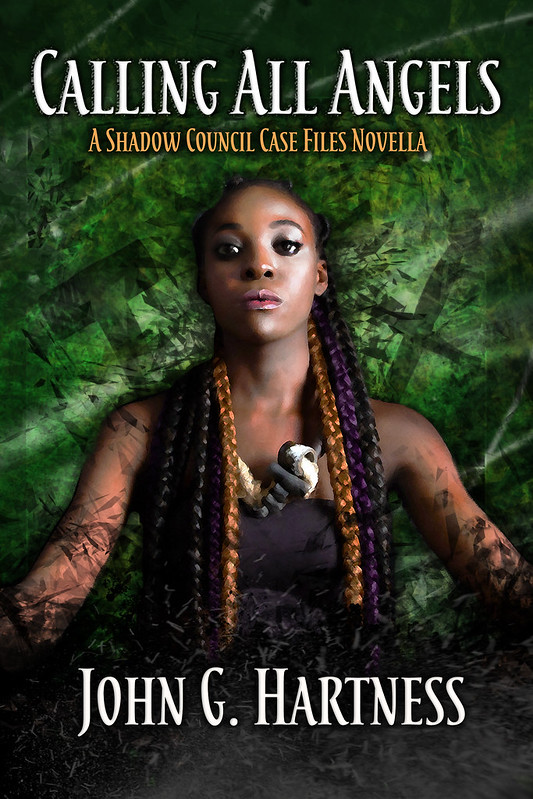
by john | Feb 22, 2017 | Business of publishing, Harker, Promos/Giveaways, Writing

Did I mention that there’s a new Quincy Harker book coming out Friday? Because there is, but it’s not a normal Harker book. In fact, everybody’s favorite demon hunter only makes one appearance in this book, and that’s by voicemail.
You see, Harker Year 3 is a huge crossover with my new series, The Shadow Council Case Files, and those two series tie together to make an 8-novella cycle called Quest for Glory. There will be four Shadow Council books, and four Harker books, and they all work together to tell the story of the team’s hunt for the archangels and the quest to get Glory her wings back, and thus restore her divinity.
The story kicks off in Calling All Angels, which features Joanna Harrison, who goes by the moniker of Jo Henry when she’s slamming a hammer into the face of demons and other baddies. She’s looking for Archangel Michael, and when she finds him, she quickly realizes that her troubles are just getting started!
This book follows immediately after Heaven Can Wait, and will be followed by the next Harker novella, Devil Inside, which should release on or before April 1.
You can pre-order it on Amazon today, and me and the cat will thank you for it!
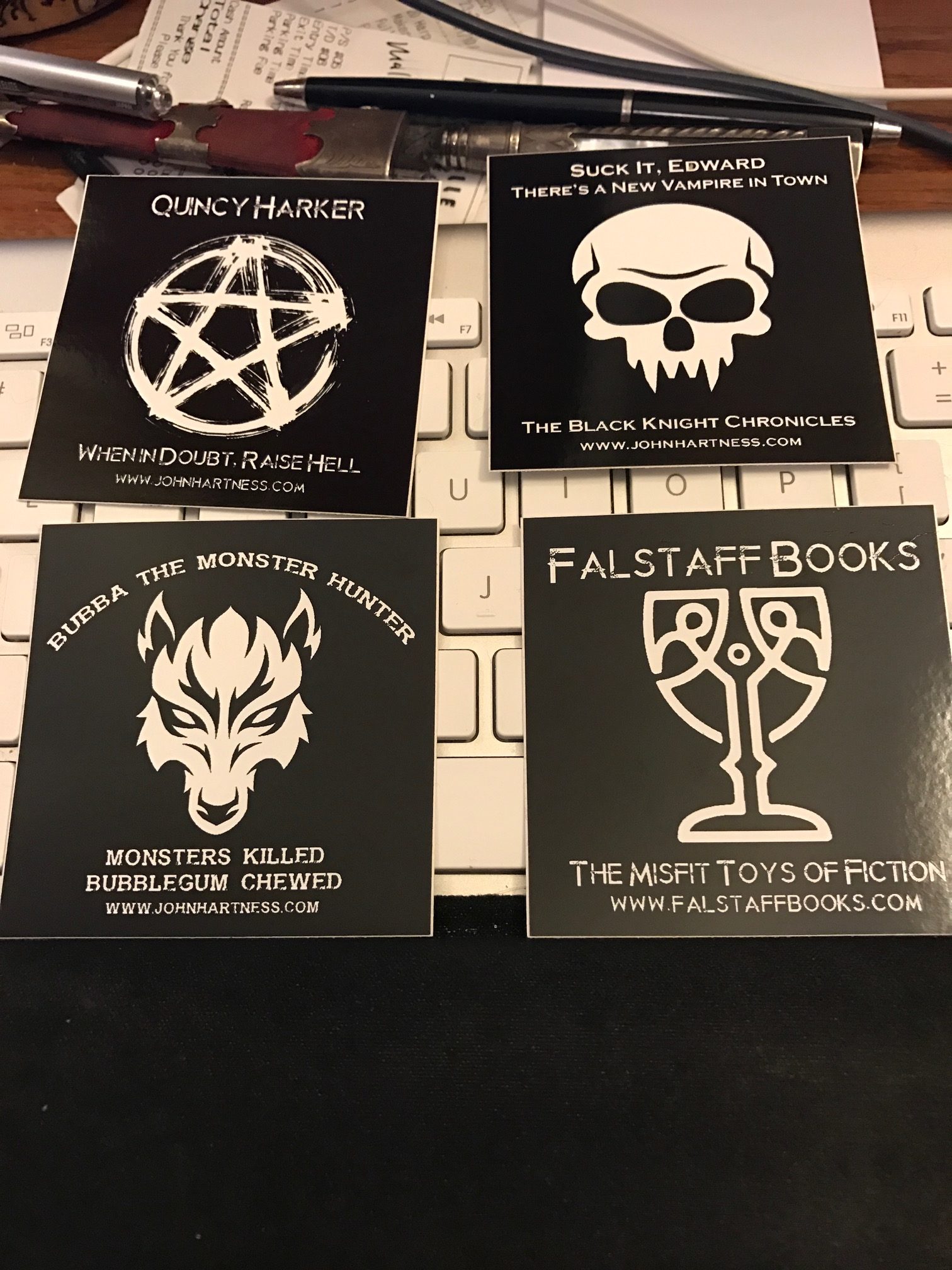
by john | Feb 22, 2017 | Business of publishing, Promos/Giveaways
So I made some stickers. There are Bubba stickers, Harker stickers, Falstaff stickers, and Black Knight stickers. I even took a picture of the stickers, but WordPress is being a dick this morning and I can upload the photo, but it’s rotated 90 degrees. When I rotate the image, it rotates it 180 degrees.
So here are some sideways stickers.
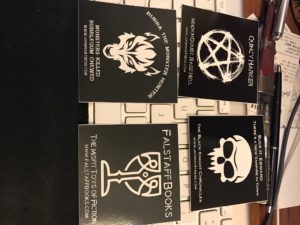
If you want some sideways stickers, there are two ways to get them.
- See me at a signing or a convention, and buy a book. I’ll put a Falstaff sticker and one of whatever sticker corresponds to the sticker in the book, along with a nifty Falstaff Books bookmark that has a link on the back to go download a free Falstaff Books ebook sampler. Yeah, that’s the link for the free ebook right there, too. Or for a buck I’ll give you all four stickers. Or if you bring me a beer to my signing table I’ll give you all four stickers. And probably a hug. Awww, fuck it, I’ll give you a hug even if you don’t bring me beer or buy anything. I’m a big fuzzy fat guy, I’m all about that Hug Life.
- You can also get stickers mailed right to your door by becoming a Patreon Patron at the $5 level or higher. You also get a bunch of other stuff, including free stories, access to the Patron-only video Q&As, and free ebooks.
So if you want stickers, I got stickers. Those images are also available on t-shirts, and if you buy one of the shirts and send me a picture of you wearing it, I’ll send you the stickers. You can get the shirts at TeePublic.
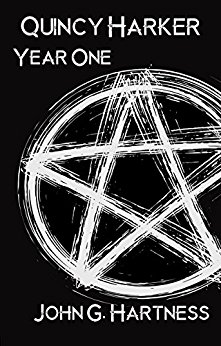
by john | Feb 6, 2017 | Business of publishing, How to Sell Books, Writing
Now that I’m in publishing, I’m working with a lot of writers. A lot of these writers are publishing their first book, or their first stand-alone work, after having been in a number of anthologies over the years. One question I get a lot of times is “How do you sell books on social media?”
Well, there are a lot of disparate opinions on that. Some people, who sell a lot of books, think that you can’t actually sell anything on social media. They feel that it’s all about building your brand, and engagement, and getting people to like you and be interested enough in you to go buy your stuff. I tend to tell those people that they have very valid opinion, and it’s one way to approach social media. These folks frequently build a very rabid following for their blogs, or their twitter feeds, and are able to parlay those readerships into readerships for their books. Chuck Wendig and John Scalzi both built a lot of their fanbase off their blogs early in their careers, and still have very popular blogs today. They’ve done a great job of building engagement, and almost surreptitiously selling their fiction while building real engagement with other things they had to say. It’s very much a good way to work it, and can be very successful.
Some other folks think that social media is the devil, and they hate it, and just want to stay in their ivory towers and write. I usually tell those people that they are not going to make much money writing, and they should leave that J.D. Salinger/Emily Dickinson shit in previous centuries where it belongs.
My method is different, and it’s one that a lot of people don’t care for, but it results in actual sales for my books, so I’m not likely to change it anytime soon.
I promote the hell out of my stuff on social media.
Like, a LOT.
Every weekend, I spend an hour or so writing tweets or copying old tweets from a master list I keep on my desktop, and I paste them into Hootsuite to automate the cross-posting to Twitter, Facebook, and my author Facebook page. Every hour on the hour from 9AM – 5PM Eastern, I send out one tweet promoting one product. Sometimes, when a product is releasing that week, it will get two tweets per day, but usually just one.
Here are some samples of things I tweet –
You need more Sasquatch dick jokes in your life. Pick up Grits, Guns & Glory, Bubba Season 2 Today! http://amzn.to/1IZQSkO
Late to the Harker Party? Check out Harker Year One for the collected adventures of this badass magician! http://amzn.to/1TxBjVG
My Patrons get exclusive content like my writing advice blog posts, cool giveaways, and free stuff! https://www.patreon.com/johnhartness
Keep up to date with all my appearances, releases, podcasts, and get a #free #ebook! Sign up for my email list – http://eepurl.com/fV4In
Typically my breakdown will be – One post per day for my mailing list. One post per day for my Patreon. One post per day for the latest Harker release. One for the newest Bubba. One for the latest Black Knight. One for an older release. One for a recent audio release. One for a release that doesn’t sell as well and needs some love, and one flex slot. Some weeks the flex slot is pimping other writers, which engenders a lot of goodwill and retweets. Some weeks it’s pimping a con I’m going to, or other guests at that con. Some weeks it’s a podcast or an Audible subscription promo code. It just depends on what I’m thinking.
This is in direct opposition to what I and other people have said for years about social media. It’s using it as a billboard, and not as a conversation. It isn’t building real connections. It isn’t creating true fans. It’s very much a shotgun approach to marketing, with almost no way of knowing whether it has any effect or not.
Except on the weeks that I don’t do this promotion, I can see a noticeable dip in sales.
So it sells books.
That’s why I keep doing it. Because it sells books. And that’s my job. One of them, anyway. That’s what’s important to remember as a writer. You have many jobs, and one of those is to sell books. It doesn’t matter if you’ve written the next War and Peace if nobody reads it. So if you have to sell War and Peace as 50 Shades of Grey, so be it. Sell the book. If you want to be a professional writer, and pay your bills with your book sales, it’s on you to sell some damn books.
“But John, I only have three stories in anthologies and one book out. How am I supposed to make nine social media posts a day?”
You’re not. You should make five or six. Make one for each anthology you have a story in. The publishers will appreciate the fuck out of it, and are likely to invite you to be in more anthologies. Trust me, we notice who promotes a book and who doesn’t. Especially if it’s a Kickstarter anthology. We know who is working to promote the hell out a Kickstarter and who sends out one tweet in the 30-day funding period. You should make one post per day for the book that you have out. And one post per day about your mailing list.
Yes, I just said that you should be on social media EVERY SINGLE DAY telling people to buy your book. Yes, it is shameless. Yes, it is unseemly. Yes, it is brazen. Yes, some writers will consider you unprofessional for doing it. And yes, it will sell books. People cannot buy the book they have never heard of, so make sure they have heard of it.
I also said that you should have a mailing list, and be actively working to build it. You should have a website, and there should be a place on the website to sign up for the mailing list. Those are people who have already expressed an interest in your work, why wouldn’t you want to be able to reach out and touch them? Even if you only have one book out now, unless that’s the only book you ever plan on writing, you need to be building a mailing list. Right damn now.
If you want to promote other authors, great. It’s a great way to make friends and influence people. But you HAVE to be visible. I am at a place now where I have invited a bunch of authors to play in my Harker and Bubba sandboxes. Some of those authors were chosen because they are extremely talented. Some were chosen because they are some of my best friends, and extremely talented. And some were chosen because they are extremely active on social media, and extremely talented. Which ones do you think I expect to sell more books?
Get out there, get visible, get active. If you think you can “just write” and make a living, go lie in the dirt with Salinger, because that career path is as dead as old J.D.
This post is part of a book I’m working on about my methods for selling books and making a living. Pretty much everything that ends up in the book will be from either posts I make here or stuff I’ve written on Magical Words in the making Money Mondays posts. So you can get all the info for free. But if you like it and find what I’m writing useful, I’ hope you’ll buy the book when it comes out next year, or consider joining my Patreon.







